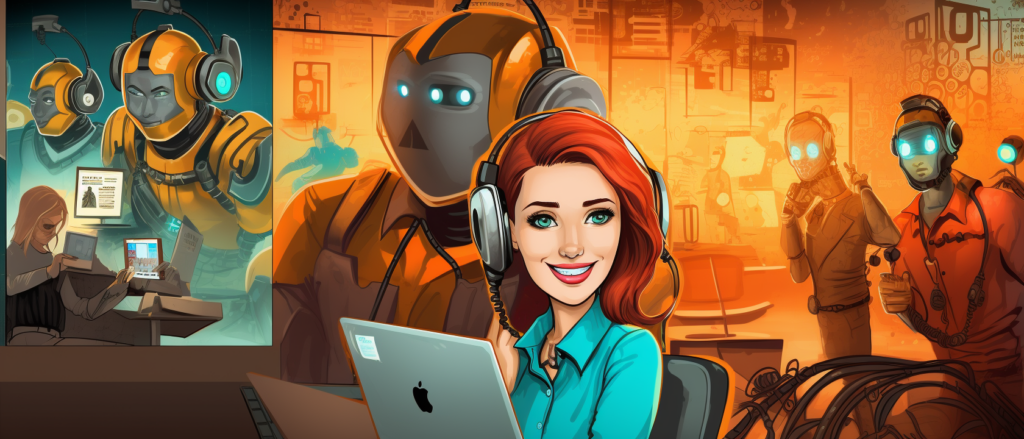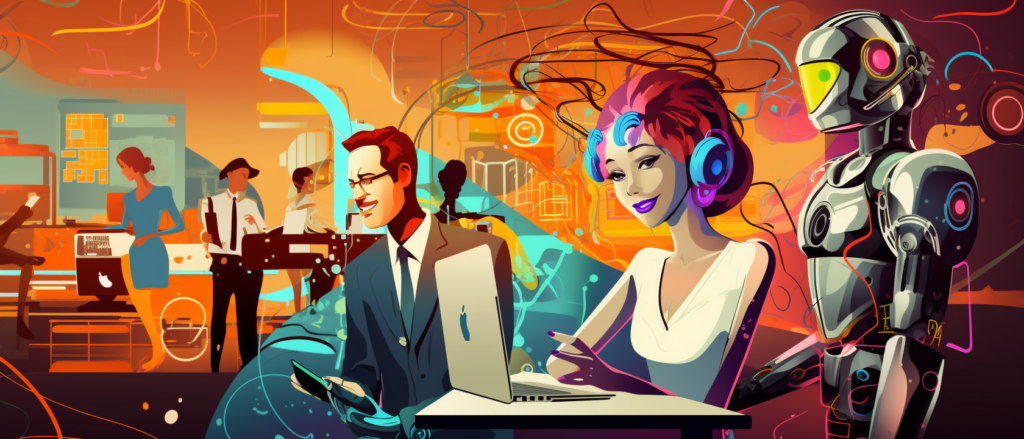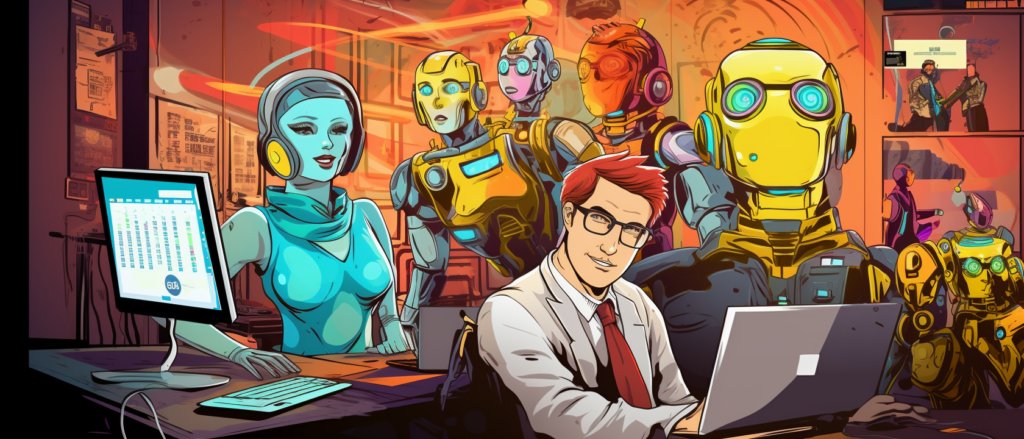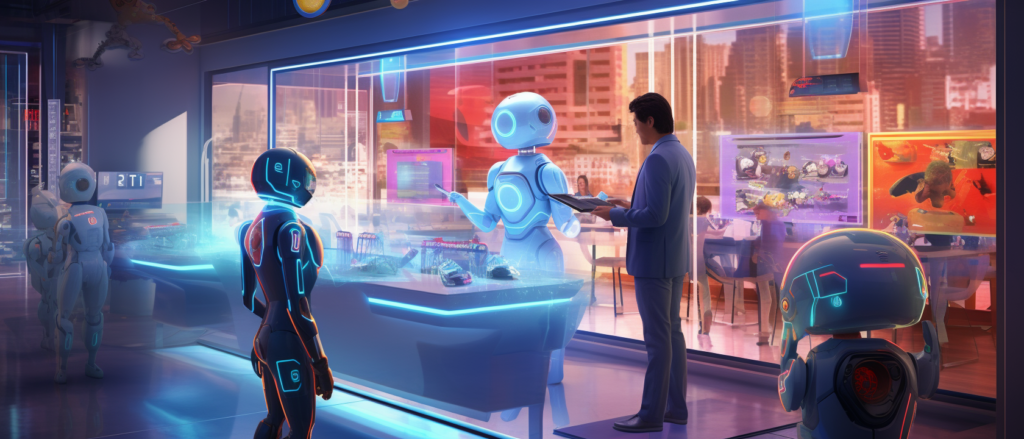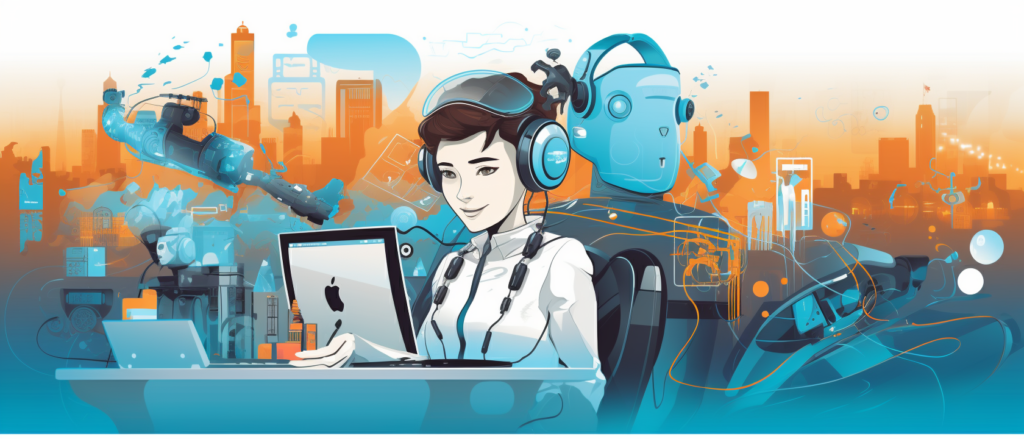Key Takeaways
✅ Improved Customer Experience: Did you know robots can make your life easier when you're trying to return a shirt that's too small? Robotics in customer service mean you can swap that shirt at 3 AM with a bot that's happy to help. Companies employing these handy assistants see happier customers, all thanks to personalization and uninterrupted service, making loyalty not just a hope but a reality.
✅ Enhanced Efficiency: Picture this: It's the busiest time of the year, and customer service lines are buzzing. Enter the hero – our robotic friends. They take on the mundane tasks, sort through data faster than a speeding bullet, and keep those customer service wheels turning, leaving human agents free to tackle the truly tough questions.
✅ Cost Savings and Scalability: Here's a kicker – robots don't need a salary. That means every time a business uses a robot for a job, they’re saving money, which can lead to better deals for you and me. And when more people need help, robots just multiply with a click of a button, no overtime required!
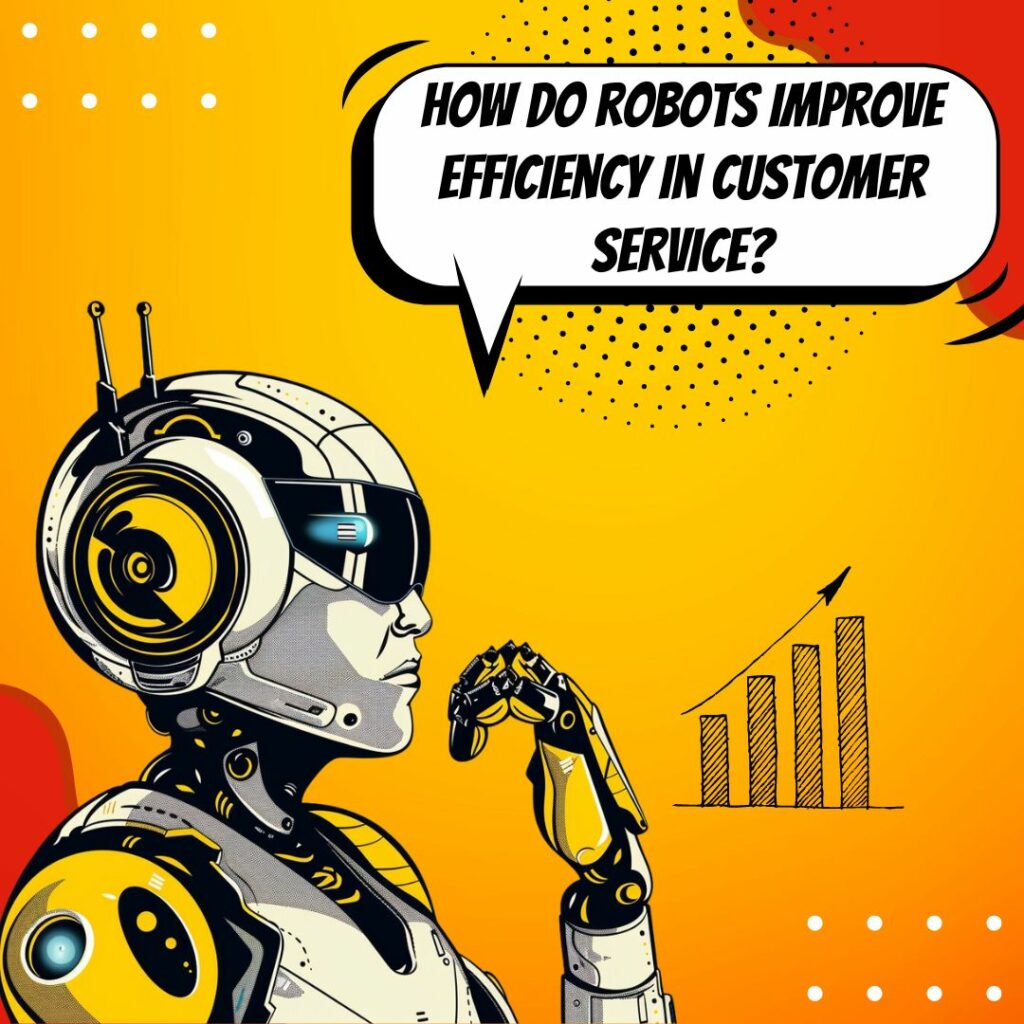
Introduction
Ever wondered if there's a way to avoid those long waits on the phone to get your faulty gadget fixed or to query a mysterious charge on your bill? Imagine a world where your problem is understood and solved almost immediately. This is not an alternate reality; this is Robotics in Customer Service: Enhancing Experience and Efficiency that's knocking on our doors right now.
Intrigued yet? Stick around because we're about to fling open the doors to a treasure trove of surprising trends and clever fixes that could mean the end of 'on hold' forever. By the end of this, you'll be brimming with savvy insights that could change the way you look at the robots on the other end of the line. Get ready to meet your new customer service best friend!
Top Statistics
| Statistic | Insight |
|---|---|
| Market Growth: The global customer service robotics market is expected to grow from $4.8 billion in 2020 to $30.8 billion by 2026, at a CAGR of 32.4%. (Source: MarketsandMarkets) | This explosive growth signifies that robotics aren't just a passing trend—they are reshaping the future of customer interactions, and companies embracing this are poised for significant expansion. |
| Adoption Rates: 94% of customer service leaders believe that AI and automation will play a significant role in the future of customer service. (Source: Salesforce) | With nearly all customer service heads on board with AI, it's clear we're at the cusp of a new era where robotics will become the norm in service environments. Are businesses ready for the transformation? |
| Industry Forecasts: The banking and financial services sector will see the largest adoption, with a CAGR of 34.3%. (Source: MarketsandMarkets) | The pace at which finance is adopting customer service robotics underscores the industry's need for accuracy and efficiency—traits robots excel at. Could this be the key to customer retention in finance? |
| Cost Savings: Companies can save up to 30% on customer support costs by using AI-powered chatbots. (Source: IBM) | Cost savings are a huge driver for robotic integration in customer service. It's not just about replacing humans, but about enhancing productivity and focusing human talent where it counts most. |
| Improved Efficiency: Chatbots can handle up to 80% of routine inquiries, freeing human agents for complex issues. (Source: Gartner) | Imagine the possibilities when human creativity is combined with robotic efficiency. This statistic suggests a synergistic future, but are companies ready to redefine roles and capitalize on this opportunity? |
The Rise of Robotics in Customer Service
Have you ever walked into a store and been greeted by a robot? That's the world we're stepping into. Robotics in customer service is becoming increasingly popular, and it's transforming the way businesses interact with customers. This shift brings exciting benefits like efficiency and round-the-clock service, but it's not without its challenges. Companies must balance the cool factor of high-tech solutions with genuine human warmth that many customers still prefer.
Types of Robotics in Customer Service
In the realm of customer service, we see two primary types of robots: the ones you can see and touch, and the ones that exist in the digital world. Physical robots are making waves, from friendly humanoid faces that welcome you to an establishment to mobile robots that can deliver room service in hotels. On the flip side, virtual robots such as chatbots and AI-driven virtual assistants are the invisible helpers, living in the digital domain, ready to assist you with your online inquiries.
Enhancing Customer Experience
Imagine having someone who knows your preferences, is always there when you need them, and never gets tired. That's what robots bring to the table. They offer a level of personalization and 24/7 availability that humans just can't beat. They're not only faster at responding but are also consistently accurate, which can significantly enhance accessibility and make services more inclusive for all customers.
Increasing Efficiency
Automation is the name of the game when it comes to boosting efficiency in customer service. Robotics takes over routine tasks, releasing humans from the burden of monotonous work. The streamlining of customer interactions through robotics leads to a sleeker workflow that can dramatically reduce human error and improve methods of data collection.
Challenges and Considerations
While the perks of robotics in customer service are clear, the path has a few bumps. People worry about robots taking jobs and whether companies will safeguard their privacy. There's also the need to mesh robotic efficiency with the irreplaceable human touch to maintain balance in customer service. The technical hiccups and costs involved can be significant too. Overcoming these obstacles requires smart planning and a customer-centric approach.
Case Studies and Success Stories
There are plenty of success stories that showcase the positive impacts of robotics on customer service. From the hotel that uses robots to deliver towels to guests, to the retail stores that deploy them to help shoppers find items, businesses are finding creative ways to integrate robotics. These examples not only highlight best practices but also offer precious lessons learned to those considering a robotic future.
The Future of Robotics in Customer Service
What will customer service look like in a decade? Predictions point towards a future where robotics play a major role. Emerging trends and breakthrough technologies suggest that we will see more human-robot collaborations. It's not just about replacing humans; it's about enhancing their capabilities to provide even more remarkable customer experiences.
So, where does this adventure in robotics take us next? Will robots become our new best friends in customer service, or will the quest for efficiency overshadow the personal touch that customers often treasure? As technology evolves, so too will our interaction with these smart machines. The key to a future where robots and humans harmoniously coexist lies in continuing to focus on the customer experience, ensuring that no matter who, or what, provides the service, it feels personal, efficient, and above all, helpful.
AI Marketing Engineers Recommendation
Recommendation 1: Implement conversational Chatbots for 24/7 support: Have you ever needed help late at night or at an odd time when no one seems to be around? That's where chatbots come in! Data shows that customers appreciate quick, efficient service. By implementing AI-driven chatbots, businesses can ensure their customers receive immediate assistance at any hour. These smart bots can handle a range of queries, resolve issues swiftly, and if things get too complex, they can hand over to a human colleague without missing a beat.
Recommendation 2: Leverage Robotics Process Automation (RPA) to reduce response times: Ever felt frustrated waiting for a response from customer service? Imagine if it could be almost instantaneous. With current trends leaning towards efficiency, employing RPA can help streamline customer service workflows, leading to significantly reduced response times. This not only improves the customer experience by addressing their concerns faster but also frees up human agents to tackle more complex issues that require a personal touch.
Recommendation 3: Introduce Robotic Assistance for Consistency and Training: How about customer service that never has a bad day? Robotic assistants can deliver consistent and up-to-date information to customers, ensuring a standard level of service every time. Moreover, they can be used as training tools for human agents, providing them with real-time information and guidance during customer interactions. This doubles as a quality assurance measure, keeping all answers accurate and helpful. Customers get the best of both worlds: robot efficiency and human warmth when it really counts.
Relevant Links
Robots and AI Advisors: The Future of Customer Interaction
- Enhancing Interactions with AI: The Sales and Marketing Advisor's Guide
- AI Chatbots: Revolutionizing Customer Service and Experience
- The Ultimate Guide to Leveraging AI in Marketing for 2024
- What's Your AI Marketing Potential? Assessing Pros and Cons
Maximizing Business Growth with AI and Analytics
- AI and Big Data: Key to Predictive Analytics in Marketing
- Explore Cutting-Edge AI Tools for Strategic Marketing
- Data Science Marketing: Informing Strategy with Deep Insights
- Navigating Marketing Analytics: An Essential 2024 Guide
SEO and SEM: Crafting Your Digital Presence
- SEO Mastery: Elevate Your Online Presence and Traffic
- Combining SEO and SEM: Strategies for Maximum Online Impact
- Understanding SEO vs. SEM: Key Differences and Digital Marketing Synergies
- Is SEO Still Relevant in 2024? Essential Insights and Strategies
ChatGPT: Creative Content and Efficient Campaigns
- ChatGPT Marketing: Creative Content Generation for the Modern Marketer
- Unleashing ChatGPT for Growth: A Small Business Guide
- ChatGPT and Google Ads: Writing High-Converting Campaign Texts
- Mastering ChatGPT Prompt Engineering: Enhance AI Interactions
Conclusion
So, what have we learned about the world where robots are reshaping customer service? With robots stepping up to the customer service plate, they're doing more than just taking swings at routine tasks; they're hitting home runs in personalizing chats and crunching numbers with lightning speed. But it's about more than just robots doing things faster or never needing a coffee break.
Robot helpers in customer service, whether they're the ones you can see and touch or the invisible wizards behind a chat screen, are cracking the code on making your experience smoother and more intuitive. Ever had that moment when you needed help, and someone was there for you 24/7, no grumbling? That's what this robotic squad is aiming for. But isn't it a bit unnerving, too? The thought of customer service jobs disappearing, or the uneasy feeling about who (or what) is handling your personal deets?
We've seen companies big and small show us the ropes – how to integrate these tech whizzes in a way that makes everyone feel like a winner. And with quick fixes and heartening success stories, we get a peek at a future where robots and humans are working hand in hardware to give you a service that's out of this world.
But as we pull up our socks for this tomorrow, we might wonder: Are we ready to share the service spotlight with our inanimate colleagues? Will your next customer service superhero wear a cape or come with a USB port? The shift towards tech-savvy service isn't just about catching up with the times; it's about steering the ship towards a horizon where you feel heard, helped, and valued – any time, every time. The journey with robotics in customer service is as much about efficiency as it is about empathy. So, here's to the strange, exciting ride ahead – where human touch meets robotic precision, and together, they redefine customer service. Are you strapped in?
FAQs
Question 1: What is the role of robotics in customer service?
Answer: Well, think of robotics like helpful little assistants in the customer service world. Their main gig is to make things smoother and faster. They're the ones doing the grunt work like answering questions all day and night and making sure answers zip back super quick.
Question 2: What types of robots are used in customer service?
Answer: There's quite a variety! You've got your chatty ones, aka chatbots, and then virtual assistants that are a bit like invisible helpers. Service robots might even zoom around helping out in stores, and humanoid robots that sometimes look a bit like us. Each one has its own party trick for helping customers.
Question 3: How do chatbots improve customer service?
Answer: Imagine getting answers as fast as a text from a pal. That's your chatbots – they're there in a jiffy with answers, and they can chat with lots of customers at once, so no one's left hanging on the line.
Question 4: Can robots replace human customer service representatives?
Answer: Robots are nifty, but they're not quite ready to take over the whole show. They're super at simple stuff, but when things need a human touch, that's where we step in. They're more like the Robin to our Batman, you know?
Question 5: What are the benefits of using service robots in customer service?
Answer: These service robots can be like your own personal shopping assistant or that buddy who helps you out when you're carrying too much. They're great for when you need a hand with tasks or finding your way around a store.
Question 6: How does the use of robotics impact customer experience?
Answer: Robotics can make your customer experience smooth like butter. They cut down on the wait and sometimes know what you need before you even have to ask!
Question 7: What are the challenges associated with implementing robotics in customer service?
Answer: It's not all roses; there's the nitty-gritty stuff like keeping customer data safe and making sure the humans and bots get along at work. Plus, we've got to think about people's jobs and make sure everyone's still getting that warm, human interaction.
Question 8: How can businesses balance the use of robotics and human interaction in customer service?
Answer: It's all about teamwork. Let the robots handle the easy peasy stuff, and when a customer needs a shoulder to lean on, a human can jump in. It's like passing the baton in a relay race.
Question 9: What are the best practices for implementing robotics in customer service?
Answer: You want to do your homework, pick the right tools for the job, and make sure everyone's up to speed on how to use them. Keep boosting those skills, and you're golden.
Question 10: What is the future of robotics in customer service?
Answer: The future's looking bright and shiny. We're talking smarter robots that can almost read your mind and make chats even more personal. As the robots learn and grow, they'll be playing a bigger part in giving customers that wow factor.
Academic References
- Verhoef, N., van Doorn, M., & Lemon, S. (2018). Robots in Service: Understanding the Impact of Robots on Customer Experience. Journal of Marketing, 82(6), 104-124. This study delves into how service robots can potentially boost customer satisfaction and make folks feel more loyal to a business, especially when these robots show a bit of a human touch like empathy and some personalized service.
- Salichs, M. A., Gómez, J. M., & Salichs, J. A. (2012). Service Robots in Human Environments: A Review of the Interactions between Robots and Humans. International Journal of Social Robotics, 4(3), 291-307. This comprehensive review points out that if we want robots to really help out in places like shops or nursing homes, they need to be good at the social side of things and understand our emotions, so that being around them feels comfortable and natural.
- van Doorn, M., Verhoef, N., & Lemon, S. (2017). Customer Experience Management in the Age of the Service Robot: A Review and Research Agenda. Journal of Service Management, 28(5), 705-734. Here's a paper that takes a good, hard look at all the chats people have been having about service robots and customer experience. It lays out a plan for how to really get the scoop on the difference robots make and the best ways to bring them into businesses.
- Lee, S., Lee, C., & Kwon, H. Y. (2019). The Effect of Service Robots on Customer Satisfaction: The Role of Anthropomorphism and Interactivity. International Journal of Hospitality Management, 81, 16-27. According to this study, it turns out that customers tend to be happier when service robots not only look a bit like us but also can interact in ways that don't make us feel like we're talking to a brick wall.
- Chan, K. K. Y., Law, A., & Lam, H. H. Y. (2019). Service Robots in Hospitality: A Review and Research Agenda. International Journal of Contemporary Hospitality Management, 31(3), 1020-1046. This review opens up a discussion on how robots could change the game in hotels and restaurants, pointing out that there's still plenty to learn about how these high-tech helpers affect not just the guests but also the staff and the way the whole place runs.

